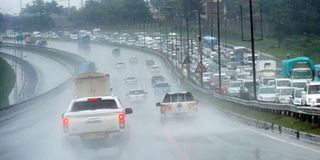Cost of flooding to be felt for years, reports show

Motorists drive through the rain on Thika Highway, Nairobi, on May 24, 2018. In the next five years, Nairobi will need Sh20 billion to improve its roads due the heavy rains currently being experienced. PHOTO | EVANS HABIL | NATION MEDIA GROUP
What you need to know:
From destruction of infrastructure, farms, livelihoods to disease outbreaks, the effect of the flooding is insurmountable.
According to a recent report by the Kenya Roads Board, there is a deficit of Sh37.6 billion in the amount required to repair roads and bridges damaged by floods.
Hundreds of Garissa residents have been rendered homeless again after their homes were submerged as River Tana burst its banks.
The cost of flooding will be felt for a long time to come as rains continue in different parts of the country.
From destruction of infrastructure, farms, livelihoods to disease outbreaks, the effect of the flooding is insurmountable.
On Friday May 25, the Kenya National Highways Authority issued an advisory to motorists using the Marua-Nanyuki Road after it exhibited cracks.
The Marua-Nanyuki highway is just one among the hundreds damaged by the flooding with such cases being reported every day.
EMERGENCIES
The authority highlighted at least 51 areas across Kenya affected by floods.
According to a recent report by the Kenya Roads Board, there is a deficit of Sh37.6 billion in the amount required to repair roads and bridges damaged by floods.
“The current allocation of the Road Maintenance Levy Fund stands at Sh44 billion against the required Sh81.6 billion,” said the report presented to the National Assembly.
Floods have compounded the problem and now road agencies require more money to handle emergencies.
DAMAGES
“The ongoing heavy rains have led to unprecedented surface runoff, resulting in flooding which has damaged roads,” Infrastructure Principal Secretary Julius Koris said in a report.
He adds: “The damage includes cut-off roads, destroyed embankments, mudslides, undermining of structures and wash-outs.”
The ministry instructed contractors to undertake emergency repairs on affected roads which included the Maai Mahiu-Narok road, Mombasa Road and others destroyed in towns and cities.
“The budget has been exhausted and we are therefore constrained in responding adequately to emergencies that arise,” Mr Korir added.
The ministry requires an emergency funding of at least Sh18 billion to give KeNHA Sh2.5 billion, Kenya Rural Roads Authority Sh11 billion and Kenya Urban Roads Authority Sh4 billion for emergency road works.
SH18 BILLION
“Meanwhile, we have made a request to the National Treasury for Sh2 billion to enable us respond to emergencies for road repairs and restoration of traffic passage,” he said.
The report indicates that roads in rural Kenya are the most affected. The floods have destroyed roads in Turkana, Wajir, Makueni, Machakos, Narok, Mandera, Garissa, Busia, Kisumu, Tana River and other counties.
During a presentation to the National Assembly Committee on Transport, Public Works and Housing, Mr Korir said the estimated cost of carrying out emergency remedial works to reinstate the roads is Sh11 billion.
He said the amount was likely to increase as the rains continue to pound parts of the country.
FUNDING
Nairobi is the most affected urban centre “because of aged roads”, the report added.
In the next five years, Nairobi will need Sh20 billion to improve its roads, according to the ministry.
In the 2017/18 financial year, Nairobi was allocated Sh850 million for roads but the amount has risen to Sh1.3 billion in the 2018/19 fiscal year.
“Despite the allocation from Kura plus Sh400 million from the county, there is need for Sh2.3 billion to bridge the maintenance gap. The shortfall in funding has resulted in poor roads,” a report from Kura said.
Meanwhile, hundreds of Garissa residents have been rendered homeless again after their homes were submerged as River Tana burst its banks. Many sought shelter in rented houses within Garissa town while others erected tents in school compounds.
WASHED AWAY
Residents who stayed put after the warning by the government over the impending floods said some of their houses have collapsed.
“It is double tragedy. Last time, all my valuables were washed away. When I was settling down, this has happened again,” said Mr Hassan Abdi from Bula Kamor.
He moved his wife and children to the town.
“I have incurred huge expenses since floods started. I wish the government could help us,” he said.
BELONGINGS
Ms Halima Mohamed, who was attempting to salvage a few belongings from her submerged house told the Nation that she didn’t have money to rent a house and sought help from relatives.
“I have taken five of my children to relatives. Three weeks ago, we were staying at Hyuga Primary School but schools are now in session,” she said yesterday.
Asked why she didn’t heed the warning, Ms Mohamed said she had nowhere else to go.
In Narok East Sub-County, Mr Mr Patrick Mwangi is distraught and not sure what to do with tonnes of unharvested tomatoes in his seven-acre farm.
DISASTER
In his neighbour’s seven-acre farm, a herd of cows are eating tomato plants.
The neighbour says he spent at least Sh1.4 million on the tomatoes and abandoned the produce when the rains hit the area two months ago
Mr Topoika Koila who grows barley, wheat and potatoes in Mau-Narok says he has never witnessed a disaster of such scale in the 17 years he has been farming.
Reported by Bernadine Mutanu, Abdimalik Hajir and Leopold Obi




